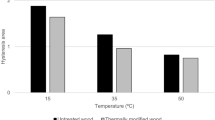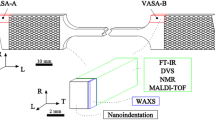Abstract
The interaction between wood,Pinus sylvestris (60% RH), and polyethyleneglycol (PEG) of different molecular weights (PEG 200 and PEG 1500), pentaerythritol and glycerol, impregnated into wood, has been investigated using Scanning Electron Microscopy (SEM), dynamical mechanical techniques (DMTA), X-ray diffraction (WAXS) and macroscopic dimensional measurement.
Reduced dimensional changes after impregnation, in environments with changing moisture content, show that the stabilization effect of glycerol impregnation is very good. The other chemicals used, especially pentaerythritol, were not as effective as glycerol.
Cell wall measurements, using SEM, show that an increase in cell wall thickness gives a corresponding increase in stabilization effect. DMTA-measurements show that interaction between wood molecules and the chemicals used differs. In general, a higher degree of cell wall penetration of the chemicals show a better stabilization effect. PEG 200 was found to penetrate the cell wall much better than PEG 1500. WAXS-investigations show free crystalline pentaerythritol, PEG 1500, glycerol and PEG 200.
Zusammenfassung
Untersucht wurde die Wechselwirkung zwischen Holz (Pinus sylvestris) und Polyethylenglykol (PEG 200 und PEG 1500), Pentaerythrit und Glycerin, mit denen das Holz imprägniert worden war. Dabei kamen folgende Methoden zum Einsatz: Raster elektronenmikroskopie (REM), dynamisch-mechanische Techniken (DMTA), Röntgenstrahlbeugung (WAXS) und makroskopische Dimensionsmessungen. Verminderte Dimensionsänderungen nach der Imprägnierung in Umgebungen mit wechselnder Feuchte zeigen einen sehr guten stabilisierenden Effekt für Glycerin. Die übrigen getesteten Chemikalien, vor allem Pentaerythrit, waren nicht so wirksam wie Glycerin. Zellwandmessungen an REM-Aufnahmen zeigen, daß parallel zum Anstieg der Zellwanddicke auch eine erhöhte Stabilisierung beobachtet wird. DMTA-Messungen lassen erkennen, daß die Wechselwirkung der einzelnen Chemikalien mit den Holzmolekülen unterschiedlich ist. Allgemein gilt, daß der Stabilisierungseffekt umso größer ist, je tiefer die Chemikalien in die Zellwand eindringen. PEG 200 dringt erwartungsgemäß tiefer ein als PEG 1500. Aus den Röntgenbeugungs-Untersuchungen ergibt sich, daß innerhalb der Zellwand freies kristallines Pentaerythrit, Glycerin, PEG 200 oder PEG 1500 vorhanden ist.
Similar content being viewed by others

References
Akitsu, H.;Norimoto, M.;Morooka, T. 1991: Vibrational properties of chemically modified wood. Mokuzai Gakkaishi. 37: 590–597
Boutelje, J. 1962: On shrinkage and change in microscopic void volume during drying, as calculated from measurements on microtome cross sections of Swedish Pine. (Pinus sylvestris L.) Svensk Papperstidn. 65: 209–215
Faucher, J. A.;Koleske, J. V.;Santee, Jr, E. R.;Stratta, J. J.;Wilson, C. W. 1966: Glass Transitions of Ethylene Oxide Polymers. J. of Appl. Physics. 37: 3962–3964
Furuno, T.;Goto, T. 1979: Structure of the interface between wood and synthetic polymer. XII. Distribution of styrene polymer in the cell wall of wood-polymer composite (WPC) and dimensional stability. Mokuzai Gakkaishi. 25: 488–495
Handa, T.; Fukuoka, M.; Yoshizawa, S.; Hashizume, Y.; Suzuki, M. 1980: The dielectric properties of wood and wood-polymer composite (WPC) containing moisture at low temperature regions. In: Proc from the 23rd Japan Congress of Materials Research-Non Metallic Materials. pp 338–343
Johansson, I. 1982: Dimensional stabilization of wood products. Swedish Forest Products Research Laboratory, Dept of Wood Technology. Sweden STFI, A772: 44–49
Morooka, T.; Akitsu, H.; Norimoto, M. 1991: Dynamic mechanical properties of chemically modified wood. In: Proc of the Int. Symp on Chemical modification of wood. Kyoto, Japan. pp 92–97
Pankevicius, E. R. 1968: Control of shrinkage in Australian timbers. I. The influence of certain bulking agents at various concentrations. Technol. Pap. Nr 54, pp 12, Div. Forest Prod, Melbourne, Australia
Schneider, A. 1969: Basic studies on dimensional stabilization of wood with polyethylene glycol. Holz Roh-Werkstoff. 27: 209–224
Wetton, R. E. 1986: Dynamic Mechanical Thermal analysis of polymers and related systems. In: Dawkins, J. V. (Ed.): Developments in Polymer Characterisation-5. pp. 179–221. Barking: Elseviers Applied Science Publishers Ltd.
Wallström, L.;Lindberg, K. A. H. 1995: Wood surface stabilization with Polyethyleneglycol, PEG. Wood Sci. Technol. 28: 109–119
Author information
Authors and Affiliations
Rights and permissions
About this article
Cite this article
Wallström, L., Lindberg, H. & Johansson, I. Wood surface stabilization. Holz als Roh-und Werkstoff 53, 87–92 (1995). https://doi.org/10.1007/BF02716397
Issue Date:
DOI: https://doi.org/10.1007/BF02716397



